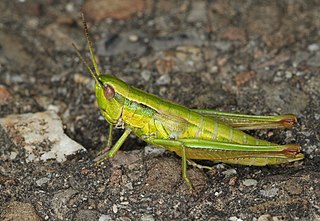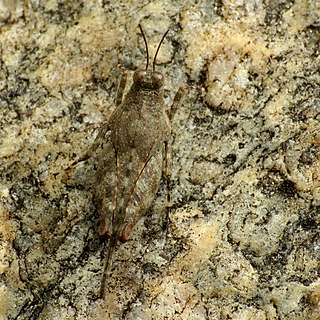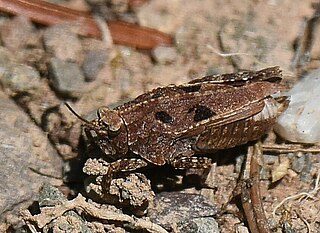
The Melanoplinae are a subfamily of grasshoppers in the family Acrididae. They are distributed across the Holarctic and Neotropical realms. They are one of the two largest subfamilies in the Acrididae. As of 2001 the Melanoplinae contained over 800 species in over 100 genera, with more species being described continuously.

Tetrigidae is an ancient family in the order Orthoptera, which also includes similar families such as crickets, grasshoppers, and their allies. Species within the Tetrigidae are variously called groundhoppers, pygmy grasshoppers, pygmy devils or "grouse locusts".

Trimerotropis is a genus of band-winged grasshoppers in the family Acrididae. There are at least 50 described species in Trimerotropis.

Gomphocerinae, sometimes called "slant-faced grasshoppers", are a subfamily of grasshoppers found on every continent but Antarctica and Australia.

Eumastacidae are a family of grasshoppers sometimes known as monkey- or matchstick grasshoppers. They usually have thin legs that are held folded at right angles to the body, sometimes close to the horizontal plane. Many species are wingless and the head is at an angle with the top of the head often jutting above the line of the thorax and abdomen. They have three segmented tarsi and have a short antenna with a knobby organ at the tip. They do not have a prosternal spine or tympanum. Most species are tropical and the diversity is greater in the Old World. They are considered primitive within the Orthoptera and feed on algae, ferns and gymnosperms, the more ancient plant groups.

Paropomala is a genus of North American grasshoppers in the subfamily Gomphocerinae. There are at least three described species in Paropomala.

Circotettix is a genus of band-winged grasshoppers in the family Acrididae. There are about 9 described species in Circotettix.

Romaleinae is a subfamily of lubber grasshoppers in the family Romaleidae, found in North and South America. More than 60 genera and 260 described species are placed in the Romaleinae.

Batrachideinae is a subfamily of groundhoppers or pygmy grasshoppers. There are thought to be 20 genera in Batrachideinae, with genera found in the Americas, Africa, Asia and Australia.

Paratettix is a genus of ground-hoppers or pygmy grasshoppers, with more than 60 described species found worldwide.

Tetriginae is a large subfamily of groundhoppers or pygmy grasshoppers. Members of Tetriginae occur on every continent except Antarctica.

Nomotettix is a genus of pygmy grasshoppers in the family Tetrigidae. There are at least three described species in Nomotettix.

Copiocerinae is a subfamily of short-horned grasshoppers in the family Acrididae. There are at least 20 genera in Copiocerinae, found in southern North America, Central America, and South America.

Orphulella is a genus of slant-faced grasshoppers in the family Acrididae. There are more than 20 described species in Orphulella, all found in the Americas.

Scaria is a genus of groundhoppers or pygmy grasshoppers in the tribe Batrachideini from South America. There are about eight described species in Scaria.

Cladonotinae is a subfamily of groundhoppers containing more than 70 genera and 260 described species. These insects are found in tropical areas world-wide.

Metrodorinae is a subfamily of groundhoppers or pygmy grasshoppers. There are at least 90 genera and more than 590 described species, found in South America, Africa and Asia.

Episactidae is a family of grasshoppers in the order Orthoptera. There are about 19 genera and more than 60 described species in Episactidae, found in Central and South America, China, and Madagascar.

The Ommatolampidinae are a subfamily of grasshoppers in the family Acrididae, found in central and South America, and based on the type genus Ommatolampis. Derived from the "Ommatolampides" used by Brunner von Wattenwyl in 1893, the first use of the name in its current form was by Rodríguez et al. in 2013; this taxon appears to be paraphyletic.





















